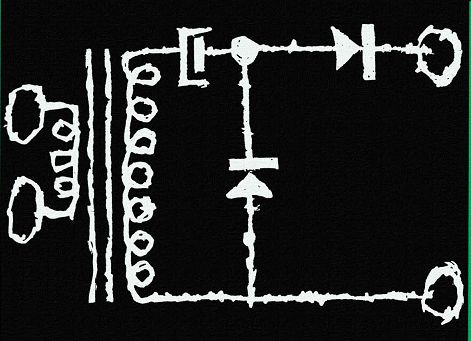AMAZON multi-meters discounts AMAZON oscilloscope discounts
Contents
Section 1 BASIC POWER-SUPPLY CIRCUITS
The Half-Wave Rectifier-The Full-Wave Rectifier-The Bridge Rectifier-The Voltage Multiplier-Comparison of the Basic Rectifier Systems-Types of Rectifiers
Section 2 POWER-SUPPLY FILTERS
The Choke-Input Filter-The Capacitor-Input Filter-Power-Supply Voltage Regulation-Output Versus Input-Reducing Output voltage-Practical Circuits
Section 3 VOLTAGE-REGULATION BASICS
Shunt Voltage Regulator-Series Operation of Gas-Filled V-R Tubes - Practical Voltage-Regulator Circuits
Section 4 CLOSED-LOOP VOLTAGE REGULATION
The Losser Element-A Series Voltage-Regulator Output-Practical Circuits
Section 5 SEMICONDUCTOR POWER SUPPLIES
Semiconductor-Rectifier Ratings-Substituting for Tube Rectifiers -A Dual Low-Voltage Power Supply-A 600-Volt "Ham-Transmitter" Power Supply-Voltage-Multiplier Circuits
Section 6 SOLID-STATE VOLTAGE REGULATION
Open-Loop Operation-Closed-Loop Operation
Section 7 CURRENT REGULATION
Regulating With a Series Resistor-Electronic Methods
Section 8 BATTERIES
Primary-Cell Operation-Internal Impedance-Mercury Cells Alkaline Cells-Solar Cells-Secondary Cells
Section 9 POWER SUPPLIES USING SCR's
Typical SCR Circuits-A Practical SCR Power Supply-Regulated Power Supplies-Controlled A-C Switches
Section 10 MISCELLANEOUS POWER-SUPPLY CIRCUITS
Transistor Power Converters and Inverters-Radio-Frequency Power Supplies
Overview of this Guide
(Note: this guide is based on now-classic Howard-Sams and TAB series of books. The content, while dated, still provides solid foundations on electronics DIY)

Power supplies work behind the scenes in practically every piece of electronic equipment. Though they are essential if a circuit is to function, they do not have an active part in amplifying or generating the signals that are the end result. The proper functioning of the power supply is usually assumed or taken for granted, yet there must be an understanding of what the power supply should and can do if these other functions are to be peformed efficiently.
There is a wide variety of components which can be arranged in many different circuits in order to provide sources of power. Vacuum tubes, gas-filled tubes, silicon rectifiers, silicon controlled rectifiers, and transistors make up only a partial list of the active elements that can be used. When assembled as half-wave rectifiers, full-wave rectifiers, bridges, or voltage multipliers, they are ready to fulfill their intended function. In most cases the basic task is to change the standard 117-volt alternating current into a form usable by an electronic circuit-usually direct current at potentials varying from 5 to 500 volts. To explain the circuits that perform this function is one of the major goals of this guide.
Voltage regulation--the ability of a power supply to maintain a steady voltage and/or current under changing conditions of load and input--is essential if many electronic circuits are to give satisfactory service. An explanation of both open-loop and closed-loop methods of regulation is given in this guide. Circuits involving both tubes and semiconductors are described and illustrated.
Silicon controlled rectifiers are being widely used where variable power supplies are essential, so an entire chapter is devoted to how they work and what they can do. The student in electronics will be anxious to try assembling a typical circuit in order to gain first-hand knowledge. All the information needed for the project is in this guide.
Batteries are assuming increased importance in these days when portability of equipment is being stressed. There have been many radical changes in their construction and potential applications in recent years. It is essential that the student and technician be familiar with the current trends in batteries, so a chapter on this subject has been included in this guide.
It is the hope of the author that the reader will construct some or all of the power supplies described herein. Every effort has been made to provide all the essential information so this can be done. The name of a manufacturer or supplier has been indicated for transformers, chokes, and other parts that might be difficult to obtain.
While this guide does not attempt to exhaust its subject, it is hoped that a careful study of its contents will provide a basic understanding of practical power-supply circuits.
Also see: